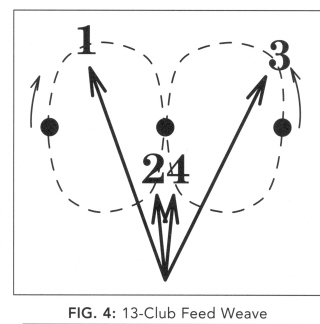|
A
nice thing about site swaps is that the average of the throw numbers
is the number of objects. In all of the site swaps we'll describe
here, for instance,
Let
me say that the first doubles you ever receive in a 1-count may be
surprising, but you can fairly easily get used to such doubles. Just
remember not to pass if you don't get a club from your partner.
Now
for some of the site swaps. We'll assume that you'll do these
continuously you start over repeating the sequence as soon as you
finish it. First, note that doing the basic 53 continuously with the 5
being a right returns you both to right-hand-only passing, so even
someone who has never passed left handed can do 53 and say they've
done a 1-count site swap. If you add a normal single after each 53,
you get 534 (double, self, single), which has a very nice
feel to it and is balanced right and left when done
continuously.
Try
633 (triple, self, self), which is very easy since the receiver has
two pauses in a row between passes and the 633 thrower has lots of
selves. Another fairly easy balanced sequence is 55514 (you can add or
remove a 4 from the end of any sequence here). 55550 is basically a
7-cIub 1-count with a hole (one person throwing straight singles and
one diagonal doubles). A surprising pattern to receive is 642.
For
the 1-count, Fig. 3 shows site swaps up 10 length five and up to
triples in height. Many,
many longer sequences exist.
For
a variation any time you want, instead of throwing a 4 as a normal
single to your partner, throw it straight up as a double self (right
to right or left to left). The timing is the same, so either type of 4
works.
In
general both jugglers can do site swaps at will, although you may
sometimes end up with a hole where you wanted a club to throw.
13-Club
Feed Weave Here's
a 13-club pattern which is a nottoo-difficult extension of the
normal fun 12-club Feed Weave (described in the Summer
1991 Juggler's Workshop). In the Feed Weave, one person feeds
three people in a normal back and forth fashion except that the three
people are weaving themselves through the three different feedee
positions. Each feedee goes forward after passing in the middle and
backwards after passing on either side and does a 6-count while
walking in this figure eight. As you get to each new position, you
exchange clubs with the feeder. Fig. 4 shows the route that the
feedees walk (almost run when going forward through the middle).
The
important thing in the 13-club pattern is for the feeder to lead the
feedees more than you would in the 12-club pattern (because doubles
come down later than singles would and hence the feedee has moved
further). The doubles from the feeder to the side positions should be
very long and lead the feedees a little towards the middle. The
feeder's passes to the middle need to be extremely short (but still
doubles).
The
feeder's passes to the left are thrown over the right shoulder of the
person coming through the middle. That's the pass we start with. That
first feedee responds by passing a double one count later and
immediately moving back and to the left to catch the feeder's long
first pass while heading for the middle feedee position.
The
feeder's next double is very short
Then
the feeder throws a long double to the right, about over the left ear
of the third feedee, who responds with a pass while being forced back
and to the right to catch the feeder's pass and to head for the
middle.
Finally
the feeder throws a very short double to the first feedee who is now
moving forward through the middle. This pass should be way outside,
leading the feedee toward the next position on that side. After this
pass the feeder starts over, with the feedees all in new positions.
The
numbered arrows in Fig. 4 indicate where the four passes in the
feeder's cycle should go. The feedees need to allow for their own
momentum when passing their doubles to the feeder. Keep those doubles
high.
Complete
3-Count Star This
is a fun pattern that I created a few years ago, and although it takes
a group of five pretty good passers and some work, it is exciting to
accomplish. It is fairly easy to describe, at least, and it takes only
three clubs per person.
The
formation is a normal star of five people equally spaced. Each person
does a 3-count and feeds the other four people in a typewriter feed
from left to right and then starts over. See Fig. 5, which shows one
person's four passes. As in a normal 3count, you alternate passes
from the right and left hands: passes 1 and 3 are from the right,
whereas 2 and 4 are from the left.
|


